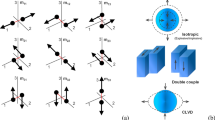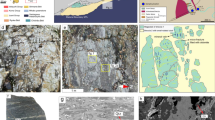Abstract
The episodic movement of deep-seated landslides is often governed by the presence of high pore pressures and reduced effective stresses along active shear surfaces. Pore pressures are subject to cyclic fluctuation under seasonal variations of groundwater recharge, resulting in an intermittent movement characterized by acceleration–deceleration phases. However, it is not always clear why certain acceleration phases reach alarming levels without a clear trigger (i.e., in the absence of an exceptional pore pressure event). This paper presents a conceptual framework linking hydromechanical cycling, progressive failure and fatigue to investigate and explain the episodic behavior of deep-seated landslides using the Campo Vallemaggia landslide in Switzerland as a case study. A combination of monitoring data and advanced numerical modeling is used. The principal processes forcing the slope into a critical disequilibrium state are analyzed as a function of rock mass damage and fatigue. Modeling results suggest that during periods of slope acceleration, the rock slope experiences localized fatigue and gradual weakening through slip along pre-existing natural fractures and yield of critically stressed intact rock bridges. At certain intervals, pockets of critically weakened rock may produce a period of enhanced slope movement in response to a small pore pressure increase similar to those routinely experienced each year. Accordingly, the distribution and connectivity of pre-existing permeable planes of weakness play a central role. These structures are often related to the rock mass’s tectonic history or initiate (and dilate) in response to stress changes that disturb the entire slope, such as glacial unloading or seismic loading via large earthquakes. The latter is discussed in detail in a companion paper to this (Gischig et al., Rock Mech Rock Eng, 2015). The results and framework presented further demonstrate that episodic movement and progressive failure of deep-seated landslides cannot be analyzed by means of classical limit equilibrium tools but require advanced numerical models. When calibrated against slope monitoring data, the improved understanding of episodic slope movements can lead to more reliable early warning forecasting and improved landslide hazard management.













Similar content being viewed by others
References
Alzo’ubi AK, Martin CD, Cruden DM (2010) Influence of tensile strength on toppling failure in centrifuge tests. Int J Rock Mech Min Sci 47:974–982
Bonzanigo L (1999) Lo slittamento di Campo Vallemaggia. PhD thesis, ETH Zurich, Switzerland
Bonzanigo L, Oppizzi P, Tornaghi M, Uggeri A (2006) Hydrodynamics and rheology: key factors in mechanisms of large landslides. In: Proceedings geohazards engineering conferences international, Lillehammer, Norway, 18–21 June 2006
Bonzanigo L, Eberhardt E, Loew S (2007) Long-term investigation of a deep-seated creeping landslide in crystalline rock. Part I: Geological and hydromechanical factors controlling the Campo Vallemaggia landslide. Can Geotech J 44(10):1157–1180
Cornaton FJ (2014) Ground water: a 3-D ground water and surface water flow, mass transport and heat transfer finite element simulator. Reference manual. Centre for Hydrogeology and Geothermics, Neuchâtel
Crosta GB, Frattini P, Agliardi F (2013) Deep seated gravitational slope deformations in the European Alps. Tectonophysics 605:13–33
Cundall PA, Hart RD (1992) Numerical modelling of discontinua. Eng Comput. 9:101–113
Eberhardt E (2008) Twenty-ninth Canadian geotechnical colloquium: the role of advanced numerical methods and geotechnical field measurements in understanding complex deep-seated rock slope failure mechanisms. Can Geotech J 45(4):484–510
Eberhardt E, Stead D, Coggan JS (2004) Numerical analysis of initiation and progressive failure in natural rock slopes—the 1991 Randa rockslide. Int J Rock Mech Min Sci 41:69–87
Eberhardt E, Bonzanigo L, Loew S (2007) Long-term investigation of a deep-seated creeping landslide in crystalline rock. Part II: Mitigation measures and numerical modelling of deep drainage at Campo Vallemaggia. Can Geotech J 44(10):1181–1199
Furuya G, Sassa K, Hiura H, Fukuoka H (1999) Mechanism of creep movement caused by landslide activity and underground erosion in crystalline schist, Shikoku Island, southwestern Japan. Eng Geol 53(3–4):311–325
Gischig VS, Moore JR, Evans KF, Amman F, Loew S (2011) Thermomechanical forcing of deep rock slope deformation: 2. The Randa rock slope instability. J Geophys Res. doi:10.1029/2011JF002007
Gischig VS, Preisig G, Eberhardt E (2015) Numerical investigation of seismically-induced rock mass fatigue as a mechanism contributing to the progressive failure of deep-seated landslides. Rock Mech Rock Eng (this issue)
Goodman RE (1980) Introduction to rock mechanics. Wiley, New York
Hansmann J, Loew S, Evans K (2012) Reversible rock-slope deformations caused by cyclic water-table fluctuations in mountain slopes of the Central Alps, Switzerland. Hydrogeol J 20(1):73–91
Harby A, Sauterleute J, Korpas M, Killingtveit A, Solvang E, Nielsen T (2013) Pumped storage hydropower. In: Stolten D, Scherer V (eds) Transition to renewable energy systems, pp 597–618
Heim A (1932) Bergsturz und Menschenleben. Fretz and Wasmuth, Zurich
Hendron AJ, Patton FD (1985) The Vaiont slide, a geotechnical analysis based on new geologic observations of the failure surface. In: Technical report GL-85-5, vol I, II. Department of the Army US Army Corps of Engineers, Washington DC
Hsiung SM, Chowdhury AH, Nataraja MS (2005) Numerical simulation of thermal-mechanical processes observed at the drift-scale heater test at Yucca Mountain, Nevada, USA. Int J Rock Mech Min Sci 42:652–666
Hungr O, Evans SG (2004) The occurrence and classification of massive rock slope failure. Felsbau (Vienna, Austria) 22:16–23
Hungr O, Leroueil S, Picarelli L (2014) The Varnes classification of landslide types, an update. Landslides 11(2):167–194
Itasca (2013) UDEC 5.0 universal distinct element code. Itasca Consulting Group, Minneapolis
Kilburn CRJ, Petley DN (2003) Forecasting giant, catastrophic slope collapse: lessons from Vajont, Northern Italy. Geomorphology 54:21–32
Leith K, Moore JR, Amman F, Loew S (2014) Subglacial extensional fracture development and implications for Alpine valley evolution. J Geophys Res Earth Surf 119:62–81
Leroueil S, Vaunat J, Picarelli L (1996) A geotechnical characterization of slope movements. In: Proceedings of the 7th international symposium on landslides, Trondheim, vol 1, pp 53–74
Löw S (1997) Wie sicher sind geologische Prognosen? Bull Angew Geol 2(2):83–97
Macfarlane DF (2009) Observations and predictions of the behaviour of large, slow-moving landslides in schist, Clyde Dam reservoir, New Zealand. Eng Geol 109(1–2):5–15
Min K-B, Rutqvist J, Tsang C-F, Jing L (2004) Stress-dependent permeability of fractured rock masses: a numerical study. Int J Rock Mech Min Sci 41:1191–1210
Müller L (1964) The rock slide in the Vaiont valley. Rock Mech Eng Geol 2:148–212
Müller L (1987) The Vajont catastrophe—a personal review. In: Leonards GA (ed) Dam failures. Engineering geology, vol 24(1–4), pp 423–444
Parriaux A, Bonnard C, Tacher L (2010) Glissements de terrain: hydrogéologie et techniques d’assainissement par drainage. In: Guide Pratique. Office Fédéral de l’Environnement (OFEV), Bern
Pedrazzini A, Jaboyedoff M, Loye A, Derron MH (2013) From deep seated slope deformation to rock avalanche: destabilization and transportation models of the Sierre landslide (Switzerland). Tectonophysics 605:149–168
Preisig G, Cornaton FJ, Perrochet P (2012) Regional flow simulation in fractured aquifers using stress-dependent parameters. Groundwater 50(3):376–385
Preisig G, Dematteis A, Torri R, Monin N, Milnes E, Perrochet P (2014) Modelling discharge rates and ground settlement induced by tunnel excavation. Rock Mech Rock Eng 47:869–884
Preisig G, Eberhardt E, Gischig V, Roche V, Van der Baan M, Valley B, Kaiser P, Duff D, Lowther R (2015) Development of connected permeability in massive crystalline rocks through hydraulic fracture propagation and shearing accompanying fluid injection. Geofluids. doi:10.1111/gfl.12097
Selli R, Trevisan L, Carloni CG, Mazzanti R, Ciabatti M (1964) La frana del Vajont. In: Giornale di Geologia, serie 20, XXXII(I), pp 1–154
Tacher L, Bonnard Ch, Laloui L, Parriaux A (2005) Modelling the behaviour of a large landslide with respect to hydrogeological and geomechanical parameter heterogeneity. Landslides 2(1):3–14
Vuillet L, Hutter K (1988) Viscous-type sliding laws for landslides. Can Geotech J 25:467–477
Watson AD, Moore DP, Stewart TW (2004) Temperature influence on rock slope movements at checkerboard creek. In: Proceedings of the 9th international symposium on landslides, Rio de Janeiro, vol 2, pp 1293–1298
Watson AD, Martin CD, Moore DP, Stewart TWG, Lorig LJ (2006) Integration of geology, monitoring and modelling to assess rockslide risk. Felsbau 24:50–58
Zangerl C, Eberhardt E, Perzlmaier S (2010) Kinematic behaviour and velocity characteristics of a complex deep-seated crystalline rockslide system in relation to its interaction with a dam reservoir. Eng Geol 112:53–67
Acknowledgments
The authors wish to thank the anonymous reviewers whose comments have helped to improve this paper, as well as Prof. K. Hutter for a careful review. Financial support of this research has been provided by the Swiss National Science Foundation (Project No. 146075) and a Natural Sciences and Engineering Research Council of Canada Discovery Grant.
Author information
Authors and Affiliations
Corresponding author
Rights and permissions
About this article
Cite this article
Preisig, G., Eberhardt, E., Smithyman, M. et al. Hydromechanical Rock Mass Fatigue in Deep-Seated Landslides Accompanying Seasonal Variations in Pore Pressures. Rock Mech Rock Eng 49, 2333–2351 (2016). https://doi.org/10.1007/s00603-016-0912-5
Received:
Accepted:
Published:
Issue Date:
DOI: https://doi.org/10.1007/s00603-016-0912-5




